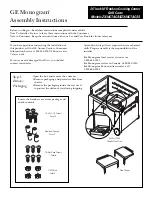
English |
17
Implement additional safety measures to protect the oper-
ator from the effects of vibration, such as servicing the
power tool and application tools, keeping their hands warm,
and organising workflows correctly.
Assembly
u
Pull the plug out of the socket before carrying out any
work on the power tool.
Auxiliary handle
u
Do not operate your power tool without the auxiliary
handle
(14)
.
u
Make sure that the auxiliary handle is always
tightened.
Otherwise you could lose control of the power
tool when working.
Swivelling the auxiliary handle (see figure A)
You can swivel the auxiliary handle
(14)
to any angle for a
safe work posture that minimises fatigue.
– Turn the lower gripping end of the auxiliary handle
(14)
anticlockwise and swivel the auxiliary handle
(14)
into
the required position. Then turn the lower gripping end of
the auxiliary handle
(14)
clockwise to retighten it.
Make sure that the retaining strap of the auxiliary handle
slots into the corresponding groove of the housing.
Selecting drill chucks and tools
Hammer drilling and chiselling require SDS-plus application
tools that are inserted into the SDS-plus drill chuck.
For drilling without impact in wood, metal, ceramic and
plastic as well as for screwdriving, tools without SDS‑plus
are used (e.g. cylindrical shank drill bits). For these tools, a
keyless chuck or a keyed chuck are required.
Changing the drill chuck
Inserting/removing the keyed chuck
GBH 2-25 / GBH 2-26
You must use a suitable drill chuck (keyed or keyless chuck,
accessories) to work with tools that do not have SDS-plus
(e.g. cylindrical shank drill bits).
Fitting the keyed chuck (see figure B)
– Screw the SDS-plus shank
(18)
into a keyed chuck
(17)
.
Secure the keyed chuck
(17)
using the securing screw
(16)
.
Note that the securing screw has a left-hand
thread.
Inserting the keyed chuck (see figure B)
– Clean and lightly grease the insertion end of the shank.
– Insert the keyed chuck with the adapter shank into the
tool holder with a turning motion until it automatically
locks.
– Check that it is locked by pulling the keyed chuck.
Removing the keyed chuck
– Push the locking sleeve
(5)
back and remove the keyed
chuck
(17)
.
Removing/inserting the quick-change chuck
GBH 2-25 F / GBH 2-26 F
Removing the Quick-Change Chuck (see figure C)
– Pull back on the quick-change chuck locking ring
(6)
, hold
it in this position and pull the SDS plus quick-change
chuck
(2)
or the keyless quick-change chuck
(1)
out from
the front.
– Once the quick-change chuck is removed, protect it from
dirt.
Inserting the Quick-Change Chuck (see figure D)
– Before insertion, clean the quick-change chuck and lightly
grease the shank.
– Wrap your whole hand around the SDS plus quick-change
chuck
(2)
or the keyless quick-change chuck
(1)
. Use a
turning motion to push the quick-change chuck into the
drill chuck holder
(19)
until you hear it click into place.
– The quick-change chuck is automatically locked. Check
that it is locked by pulling on the quick-change chuck.
Changing the Tool
The dust protection cap
(4)
largely prevents the penetration
of drilling dust into the tool holder during operation. When
inserting the tool, make sure that the dust protection cap
(4)
does not become damaged.
u
Replace a damaged dust protection cap immediately.
It is recommended that you have use an after-sales
service for this.
Changing the tool (SDS plus)
Inserting SDS-plus application tools (see figure E)
The SDS-plus drill chuck enables you to change the applica-
tion tool easily and conveniently without needing to use ad-
ditional tools.
– Clean and lightly grease the insertion end of the applica-
tion tool.
– Insert the application tool into the tool holder while turn-
ing it until it locks automatically.
– Check the latching by pulling the tool.
As a requirement of the system, the SDS-plus application
tool can move freely. This causes a certain radial run-out at
no-load, which has no effect on the accuracy of the drill hole,
as the drill bit centres itself upon drilling.
Removing SDS-plus application tools (see figure F)
– Push the locking sleeve
(5)
back and remove the applica-
tion tool.
Changing the keyed chuck
GBH 2-25 / GBH 2-26
Inserting the application tool
Note:
Application tools that do not have SDS plus must not
be used for hammer drilling or chiselling. Tools without SDS
plus and their drill chucks are damaged by hammer drilling
or chiselling.
– Insert a keyed chuck
(17)
.
– Open the keyed chuck
(17)
by turning it until the tool can
be inserted. Insert the tool.
Bosch Power Tools
1 609 92A 80X | (01.07.2022)
















































